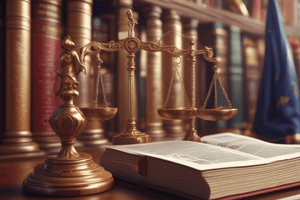Podcast
Questions and Answers
What does the 'sources of law' generally refer to?
What does the 'sources of law' generally refer to?
- The location where laws are enforced
- The governmental departments that create laws
- The origin from which rules of human conduct come into existence and derive legal force (correct)
- The physical documents where laws are written
Why is understanding the sources of law important for lawmakers?
Why is understanding the sources of law important for lawmakers?
- It helps ensure laws are applied appropriately and serve societal interests. (correct)
- It is not important for lawmakers.
- It is only important for the individuals.
- It helps them create complex legal codes.
When do legal rules potentially conflict?
When do legal rules potentially conflict?
- When they are newly created.
- When they are interpreted by different courts.
- When they are created by the same legislative body.
- When they are applied. (correct)
Into what two main categories are the sources of law divided?
Into what two main categories are the sources of law divided?
Which of the following is an example of a written source of law?
Which of the following is an example of a written source of law?
Which of the following is considered an unwritten source of law?
Which of the following is considered an unwritten source of law?
What are the two types of Informal Sources of law?
What are the two types of Informal Sources of law?
What do formal sources of law include?
What do formal sources of law include?
What is a key characteristic of the rules derived from formal sources of law?
What is a key characteristic of the rules derived from formal sources of law?
What is required for written sources of law in terms of their form?
What is required for written sources of law in terms of their form?
Which of the following is the first source of law?
Which of the following is the first source of law?
What is the Constitution primarily responsible for?
What is the Constitution primarily responsible for?
What do constitutions typically determine?
What do constitutions typically determine?
What is 'legislation' defined as?
What is 'legislation' defined as?
What is a key characteristic of legislation?
What is a key characteristic of legislation?
What is one of the main purposes of legislation?
What is one of the main purposes of legislation?
What is a decree?
What is a decree?
Who is typically responsible for drafting and issuing a decree?
Who is typically responsible for drafting and issuing a decree?
What is an international treaty defined as?
What is an international treaty defined as?
With whom are international treaties made with?
With whom are international treaties made with?
Once ratified, what is the binding force of international treaties?
Once ratified, what is the binding force of international treaties?
What is a statute?
What is a statute?
What do regulations primarily focus on?
What do regulations primarily focus on?
Who issues statutes?
Who issues statutes?
For statutes to enter into force, what must happen?
For statutes to enter into force, what must happen?
Flashcards
Sources of law
Sources of law
The origin from which rules of human conduct came into existence and derived legal force or binding characters.
Importance of sources of law
Importance of sources of law
Understanding them is important for lawmakers and individuals.
Application of the law
Application of the law
Helps individuals apply the law and helps to decide which rule is appropriate to apply in a specific case.
Main Categories of Law Sources
Main Categories of Law Sources
Signup and view all the flashcards
Written Sources of Law
Written Sources of Law
Signup and view all the flashcards
Unwritten Sources
Unwritten Sources
Signup and view all the flashcards
Informal Sources of Law
Informal Sources of Law
Signup and view all the flashcards
Formal Sources of Law
Formal Sources of Law
Signup and view all the flashcards
Written Sources of Law
Written Sources of Law
Signup and view all the flashcards
Constitution
Constitution
Signup and view all the flashcards
Main subjects of a Constitution
Main subjects of a Constitution
Signup and view all the flashcards
Legislation
Legislation
Signup and view all the flashcards
Main Features of Legislation
Main Features of Legislation
Signup and view all the flashcards
Decree
Decree
Signup and view all the flashcards
Main Features of Decree
Main Features of Decree
Signup and view all the flashcards
International Treaties
International Treaties
Signup and view all the flashcards
Main Features of International Treaties
Main Features of International Treaties
Signup and view all the flashcards
Statutes and Regulations
Statutes and Regulations
Signup and view all the flashcards
Main Features of Statutes and Regulations
Main Features of Statutes and Regulations
Signup and view all the flashcards
Study Notes
- Sources of law refers to the origin from which rules of human conduct come into existence, deriving legal force or binding characters.
Importance of Sources of Law
- Understanding sources of law is crucial for both lawmakers and individuals.
- Legislators create laws for societal application, thus law-making's primary goal is societal obedience.
- Understanding sources of law helps achieve application of the law, and how to handle conflict of laws.
- Understanding the sources of law from individuals aids in immediate law application, out of respect for the state or fear of consequences.
- Knowing the source of a specific legal rule helps determine the appropriate rule to apply when legal rules conflict.
Types of Sources of Law
- Sources of law are divided into Formal and Informal Sources.
- Formal sources are divided into Written and Unwritten sources.
- Written sources include constitution, legislation, decree, international treaty, statute, and regulation.
- Unwritten sources include custom.
- Informal sources are divided into case-law and legal scientific opinions.
Formal Sources of Law
- Formal sources include all legal rules that judicial bodies consider when making decisions.
- Formal source rules are binding and derive legitimacy from their source.
- These rules cannot be violated by individuals based on illegality claims.
- Formal sources are also classified as written and unwritten.
Written Sources of Law
- Consist of legal rules established by state organs.
- It must be published in the Official Journal of the state.
- Encompasses the constitution, legislation, decree, international treaty, statute, and regulation.
The Constitution
- It is the primary source of law.
- Functions as the fundamental text establishing the state's organizational and functional framework
- The constitution determines the form of the State, the political regime, the relationship between state institutions, and the fundamental rights of citizens.
- Constitutions cover subjects such as the State's form, the political regime, relationships between state institutions, and citizens' fundamental rights.
Legislation
- Legislation consists of legal texts produced by the legislature.
- Legislation appears above regulations, according to the state constitution and hierarchy of norms, and contains abstract rules.
- Types of legislation include constitutional laws (modifies the constitution), organic laws (apply articles of the constitution), and ordinary laws (adopted at the end of the parliamentary processes).
Main Features of Legislation
- Legislation must be written.
- All state legislations are written and called positive law, or legislative law.
- Legislation generally regulates matters related for everyone in equal measure
- Its legislation is applied continuously.
Decree
- It is an order issued by the head of state (e.g., president or monarch).
- Decrees follow procedures established in the constitution.
Main Features of Decree
- Decrees possess the force of law and its drafting/promulgation is the executive power's responsibility.
- Decrees are often used to implement a law.
- Decrees must be published in the official journal of the state.
International Treaties
- An international treaty is a written agreement between international law subjects, producing legal effects and governed by international law.
Main Features of International Treaties
- International treaties involve agreements between states or between states and international organizations.
- Agreements regulate international issues related to the relationships between states.
- With ratification by Parliament or Referendum, treaties possess a binding force greater than a law and the constitution in specific situations.
Statutes and Regulations
- A statute is a legal regulation set of provisions of formal and objective rules for a given legal situation.
- Regulations govern the practical details and applications of the law.
Main Features of Statutes and Regulations
- Statutes are regulations issued by the council of ministers/parliament to demonstrate the implementation of law.
- Statutes take effect once signed by the President and published in the Official Journal.
- The statutes must comply with the constitution.
Studying That Suits You
Use AI to generate personalized quizzes and flashcards to suit your learning preferences.




